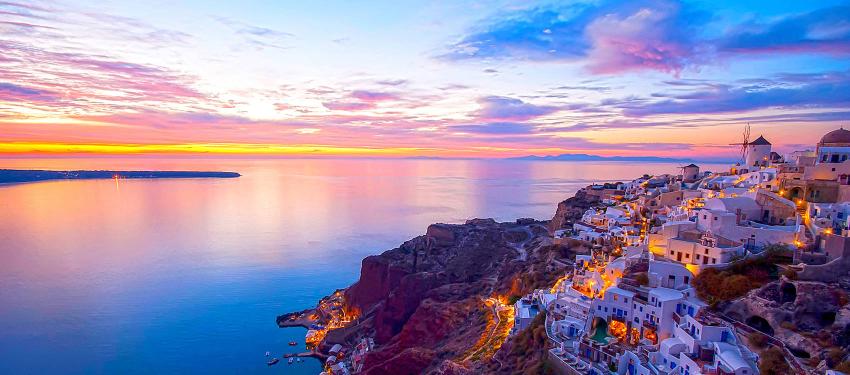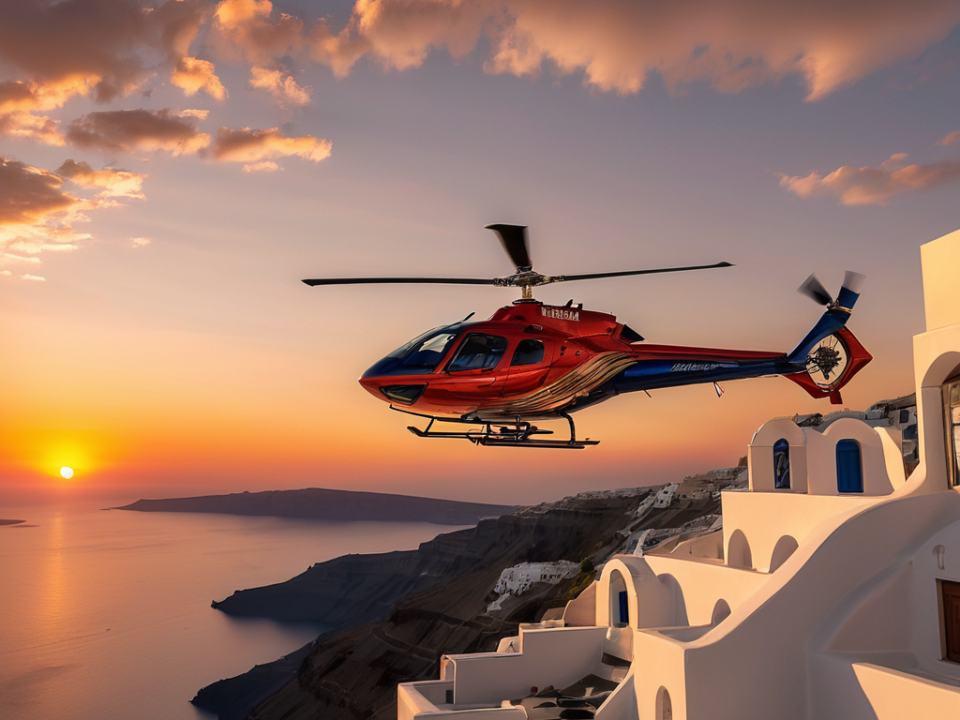- Call us and fly to Santorini!
- +30 210 99 67 870
- +306932332090
- info@santorinihelitours.com


A comprehensive guide to vacationing in Santorini:
Santorini Vacation Guide
Santorini is renowned worldwide for its unique natural beauty and extraordinary volcanic landscape. The island uniquely combines the wild beauty of its volcano and caldera with cultivated plains and traditional architecture, creating a remarkable landscape.
As a modern tourist destination with thousands of visitors annually, Santorini skillfully blends high service standards with the unpretentious traditional life and daily routines of its inhabitants.
Santorini is a top Mediterranean travel destination for good reason. From the volcanic landscape of the Caldera, the unique beaches with sculptural black sand rocks, to the remarkable archaeological site of Akrotiri, Santorini’s luxury accommodation in upscale units with stunning views, haute cuisine and gourmet restaurants, and vibrant nightlife, excursions, and discoveries in the interesting hinterland make it a unique island.
The magical and inspired landscapes infiltrate Santorini’s lifestyle and the foundation of its tourist development. Beyond its beaches, Santorini offers visitors a variety of activities such as walking in its unique nature, mountains, and vineyards, and visiting beautiful villages and archaeological sites.
Pyrgos, Emporeio, and Megalochori are villages for those who want to admire a more traditional side of Santorini.
Architecture
The island’s architecture features white houses with blue doors and windows, built amphitheatrically, reflecting the island’s burnt black land. The Kastelias (castles) and Goulades are two of the most significant architectural features on the island. The Kastelias were entire villages fortified to protect the inhabitants from pirate raids, while Goulades were smaller fortified buildings.
Arts
Since ancient times, Santorinians have specialized in the art of pottery, representing the finesse and sensitivity of their character. Today, the island hosts numerous pottery workshops where young people learn the art from the old masters. There are also many workshops for gold and silver, as well as exhibitions of contemporary jewelry, adding a cosmopolitan touch to the island.
Tradition
The inhabitants of the island love music and dance and, like all Cycladic residents, participate in celebrations during the island’s festivals. The cultural associations of the island, especially during the summer months, organize music nights, theatrical performances, dances, and activities aimed at preserving local traditions.
Myth and History
According to mythology, Cadmus, the king of Phoenicia, looking for his sister Europa (who was abducted by Zeus transformed into a bull), stopped at Calliste, now known as “Santorini,” and left his son Theras there, the first inhabitant of the island.
Herodotus claims that the first inhabitants of the island were Dorians. The first settler, Theras, named the island after himself, “Thera” being the ancient name of Santorini.
During the Persian Wars, Santorini was subdued by the Persians. After the wars, the island sided with Sparta, then later submitted to Athens.
Like all Cycladic islands, Santorini was occupied by the Macedonians, the Ptolemies of Egypt, and the Romans.
During the Byzantine Era, the island was part of the Aegean Sea Scheme and was conquered by the Venetians in 1207, who culturally influenced the island and converted many locals to Catholicism.
Santorini also faced pirate raids. After the last raid by the pirate Barbarossa in 1537, the island was conquered by the Turks, who governed it until 1821 when Santorini, along with the other Cycladic islands, was liberated.
Vacations in Santorini
Santorini is a wonderful island with a fascinating landscape due to its volcanic heritage. It’s an ideal destination for those seeking a cosmopolitan scene with the promise of discovering beautiful rural areas where traditional ways of life continue.
These traditions include the canaves (traditional dwellings carved into the volcanic rock), many of which have been converted into luxurious hotels today. Throughout the island, you can see vineyards where you have the opportunity to taste local wines.
Across the island are tiny churches waiting to be discovered, and in taverns, you can taste local dishes cooked in traditional Santorinian ways.
Cuisine
Santorini’s local products are of excellent quality but are produced in small quantities. Specialties of the island include the Santorini tomato, which grows here only after adapting to the landscape due to the lack of water.
When tasting local cuisine, do not miss the tomato fritters. Other products include white eggplant, fava, small spherical zucchinis, and capers. It’s worth trying the local chloro cheese, made from goat’s milk.
Santorini’s wines are among the best in the world, so make sure to visit a winery while you’re there. Local wines include Assyrtiko and Vinsanto.
The Volcano
If you’re expecting to see lava erupting from a crater, you’ll be disappointed as the thermal baths are more tepid than hot. However, when visiting the volcano, be prepared for heat, exhaustion, and the smell of sulfur at the summit.
It’s prohibited to take rocks from the volcano, but you can always buy one from the shops in Fira as a souvenir for a few euros. Don’t miss the annual Ifestia Festival in September with fireworks and musical events.
Activities
The island can host visitors all year round, making it an excellent destination for a variety of sports like water sports, swimming in the sea and pools, fishing, hiking, walking, tennis, and diving. Facilities for football, basketball, and volleyball are also available.
Villages of Santorini
Fira
The capital of Santorini, Fira, is built on the western side of the island on a cliff 260 meters high, offering a magnificent view of the sea.
It’s a beautiful town with about 1,600 residents, white houses gleaming under the sun, small picturesque, pebbled alleys, and stairs with domes and arches.
Inhabited for the last two centuries when it ceased to be threatened by pirate raids that prevented settlement near the sea.
Its name is believed to derive from the word “pyrros” meaning fiery or reddish, linked to the existing volcano.
Descending the narrow path of 500 steps to the old port offers a unique experience, allowing visitors to admire the magical view and beauty of the city, especially at night.
In the city, there is a series of beautiful churches and monasteries, such as the Church of Saint Minas, the Cathedral of the Presentation of Christ, the Dominican Monastery of Our Lady, and the Panagia Rodariou, which has a small collection of ecclesiastical jewels, paintings, documents, and maps.
An archaeological museum operates in Fira with notable exhibits from excavations on the island. From Fira, it’s also worth visiting (by boat) the volcano of Nea and Palia Kameni.
Kamari
Kamari is one of the most important holiday settlements in Santorini, highly developed for tourism, and located 10 km southeast of Fira. The area has been inhabited since antiquity when it was the port of Ancient Thira and was called Oia.
However, the settlement’s remarkable recent development is due to its sandy beach, which attracts throngs of tourists in the summer. The village has modern infrastructure with plenty of amenities and is close to Santorini’s airport.
There is a large pedestrian street for a pleasant walk overflowing with shops, restaurants, taverns, and cafe-bars where you can relax and enjoy the sea breeze.
From Kamari, one can travel to the nearby islet Anafi by boat or visit the Archaeological Site of Ancient Thira.
Megalochori
The beautiful village of Megalochori in the inland area with 400 residents is located 4 km southeast of Fira. The traditional houses and mansions maintain all the characteristics of the Cycladic architectural style. The inhabitants mainly live off agriculture, particularly producing excellent local wine.
They are active and hardworking, proven in 1929 when they established the “Ophthalmic Hospital of Thera Agia Varvara” to address the increased cases of trachoma among the islanders.
From Megalochori, one can visit the picturesque churches of Panagia Sergena and Panagia Trypa near the nearby village of Vothonas, which are truly carved into the rocks.
Oia
The beautiful tourist settlement of Oia is located 11 km north of Fira. During the Frankish rule, it began to flourish, making Oia one of the five most important settlements on the island, and until World War II, it was a significant commercial center.
The two-story houses and mansions with beautiful colors and well-maintained courtyards appear to “climb” the steep cliff, while traditional churches in blue and other colors rise among them, such as the church of Agios Sozon from 1680.
In Oia, there is a significant Naval Museum with a small library and some interesting exhibits from the maritime life of the inhabitants. From Oia, one can visit the nearby island of Thirasia by boat.
Perissa: Located 15 km southeast of Fira, Perissa is a coastal tourist settlement that has experienced significant development due to its large, organized beach. The center is dotted with small taverns, restaurants, bars, and hotels. The village is characterized by picturesque houses built around the large church of the Holy Cross and surrounded by scattered churches, such as the 16th-17th century church of Saint Irene. Notably, the archaeological site of Ancient Thera on Mesa Vouno, a part of Ancient Aegida, is a must-visit.
Pyrgos: As Santorini’s most mountainous village, Pyrgos, with about 500 residents, is located 7.5 km southeast of Fira. This medieval settlement was the island’s capital until 1800. Its beautiful houses are built around the central Venetian castle, which served as a refuge during pirate invasions. The fortress of Kasteli, atop the village, offers breathtaking views. Significant attractions include the 10th-century church of Theotokaki with its exquisite wood-carved iconostasis, beautiful frescoes, and old icons. Nearby, at a distance of 4 km, lies the monastery of Prophet Elias, housing valuable ecclesiastical treasures and rare manuscripts.
Vourvoulos: A traditional village on the island’s eastern side, near Fira, Vourvoulos offers a tranquil atmosphere with views of both the valley and the sea, approximately 1.5 km away. It has an organized beach where one can enjoy sunsets, moonlit nights, and sunrises. The village is well-connected with transportation to the beach and other parts of the island, including direct access to Oia. Facilities include two taverns, a mini-market, an ice-cream shop, and a bar next to a swimming pool.
Accommodation in Santorini: Hosting over a million visitors annually, Santorini offers a wide range of holiday accommodations. Luxury hotels dominate the best views around the caldera rim, but there are more affordable options for budget travelers. Early booking is advised for lower-priced rooms. Camping is available on the outskirts of Fira, with bungalows for rent, and another camping site in Perissa. Kamari, packed with hotels, caters mainly to the package holiday market.
Best Time to Visit Santorini: The island enjoys a typical Mediterranean climate with mild winters and long, warm summers. Northeast winds in summer help relieve humidity. Spring temperatures surpass 20°C in May and sharply rise in June, often reaching 30°C. Local beach temperatures may spike higher on the black volcanic sand. Rain is rare. The rainy season lasts from November to late March, but prolonged rainfall is uncommon, and warm, sunny days are typical in winter. Clear skies, temperatures around 15°C, and five hours of winter sunshine are normal.
Getting to Santorini:
By Air with Santorini Helitours: For a unique and luxurious experience, consider traveling to Santorini via helicopter. Santorini Helitours offers exclusive aerial transfers and tours, providing an opportunity to witness the stunning beauty of the Aegean Sea and the Cyclades from above. This service is ideal for those seeking a quick, scenic, and memorable journey to the island. With Santorini Helitours, you can enjoy the convenience and luxury of helicopter travel, making your trip to Santorini even more special and unforgettable. For more details and to arrange your flight, you can contact us.
By Air: Daily domestic flights from Athens last 30-40 minutes, and flights from Thessaloniki about 90 minutes. The airport, though small, can become crowded at times. It operates both as a military and a civilian airport. Buses to Fira are available in summer, and taxis are also an option.
By Sea: Frequent ferry connections in the summer link Santorini to mainland ports in Piraeus and Rafina. The main route from Piraeus, via Paros, Naxos, and Ios, takes about 7 hours. Ferries also connect to many other islands. Daily local excursions explore Santorini and the volcanic islands in the caldera.
Getting Around Santorini: Roads are generally good, but hilly terrains can be challenging to navigate, with steep drops, unfenced turns, and unlit intersections. The bus service is efficient, with frequent and timely schedules, although buses can get crowded. In summer, buses depart from Thera every 30 minutes to Oia, Monolithos, Kamari, and Perissa, and hourly to Akrotiri. Routes to Perissa and Perivolos vary based on demand. Taxis are scarce due to the high number of tourists in summer. The main taxi station is next to the central bus station in Fira.
Embark on Exceptional Journeys with Santorini Heli Tours
🌟 Your Dream Travel, Tailored by Experts 🚁
At Santorini Heli Tours, our dedicated team is committed to curating your ultimate travel experience. Whether it’s navigating the skies on a bespoke journey or accessing our elite concierge services, we’re here to turn your dreams into reality.
📞 Get in Touch for Customized Assistance:
- Call us at: +30 210 996 7870
- Direct inquiries: +30 693 233 2090
- Email: info@santorinihelitours.gr
Santorini Heli Tours – Crafting Unforgettable Skies!



